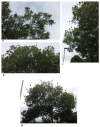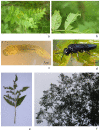First Report of the Ash Sawfly, Tomostethus nigritus, Established on Fraxinus excelsior in the Republic of Ireland
- PMID: 35055849
- PMCID: PMC8779257
- DOI: 10.3390/insects13010006
First Report of the Ash Sawfly, Tomostethus nigritus, Established on Fraxinus excelsior in the Republic of Ireland
Abstract
This is the first report of the ash sawfly, Tomostethus nigritus, in the Republic of Ireland. We observed defoliated leaves of Fraxinus excelsior L. and T. nigritus larvae at a forestry plantation in Co. Kildare. Morphological observation of the larvae and DNA analysis using mitochondrial COI barcoding confirmed the identification of this pest of ash.
Keywords: Fraxinus spp.; Republic of Ireland; Tomostethus nigritus; ash sawflies.
Conflict of interest statement
The authors declare no conflict of interest. The funders had no role in the design of the study; in the collection, analyses, or interpretation of data; in the writing of the manuscript, or in the decision to publish the results.
Figures



References
-
- Jess S., Murchie A., Allen D., Crory A. First observation of Tomostethus nigritus (Fabricius) (Hymenoptera: Tenthredinidae) on urban ash trees in Ireland. Irish Nat. J. 2017;35:134–136.
-
- Verheyde F., Sioen G. Outbreaks of Tomostethus nigritus (Fabricius, 1804) (Hymenoptera, Tenthredinidae) on Fraxinus angustifolia ‘Raywood’ in Belgium. J. Hymenopt. Res. 2019;72:67–81. doi: 10.3897/jhr.72.38284. - DOI
-
- Pschorn-Walcher H., Altenhofer E. Langjährige Lärvenaufsammlungen und Zuchten von Pflanzenwespen (Hymenoptera, Symphyta) in Mitteleuropa. Linzer Biol. Beiträge. 2000;32:273–327.
-
- Pschorn-Walcher H. Unterordnung Symphyta, Pflanzenwespen. In: Schwenke W., editor. Die Forstschädlinge Europas. Volume 4. Paul Parey; Hamburg/Berlin, Germany: 1982. pp. 232–234.
-
- Matošević D., Hrašovec B., Pernek M. Spread and character of Tomostethus nigritus F. outbreaks in Croatia during the last decade. Ecol. Surv. Manag. For. Insects Proc. 2003;311:39–43.
Grants and funding
LinkOut - more resources
Full Text Sources
Research Materials
Miscellaneous

